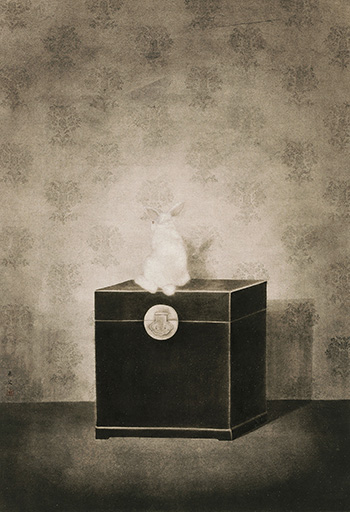LITERATURE:
New Ink Exhibition, Beijing Ronghuatang Publishing, Beijing, 2006, p.84
New Gongbi Painting Collection Book: Qin Ai Volume,Anhui Fine Art Publishing House, Anhui, 2010, p.17,99
Concept Transcendence: Qin Ai's Personal Collections, Chinese Fine Art Publishing House, Beijing, 2012, p.29,60,61
No Art, Issue no.58, Beijing, 2015, p.180
Catalogue Note
Treasure Chest Series: Chang’e
QIN AI
Animals painted by Qin Ai do not exist as appeared, they were isolated from the reality and placed in the foreground with a dramatic background which add a hint of surrealism to her works.
Qin Ai graduated from Nanjing University of the Arts in 1996, earning a degree from the Chinese Painting Department of the College of Fine Arts. She currently lives and works in Nanjing, and is one of the most important contemporary female artists in the field of gongbi painting. Freely mixing and rearranging classical elements, she favors a surrealistic style and meticulous technique to create unique and often dreamlike images. In 2006, she began to work on a series of paintings titled Treasure Chest, in which she combines scrupulously realist form with traditional style and atmosphere to freely express her emotional world. Qin has a deep root of cultural heritage and this can be seen with her reliance of traditional symbols, such as, the conventional Chinese wooden chest, painting from Song Dynasty that embellish the chest, and the complexity of the wallpaper from the background. Traditional gongbi seldom treats it background with perspective, however under the influence of modern art and Western concepts, contemporary painters in the Chinese realist style are adopting novel approaches in terms of both form and aesthetics, and this is also true of Qin Ai.
In this lot, titled Treasure Chest—Chang'e, the mythical Jade Hare stares at the background, largely made up of patterned wallpaper. The hare itself is bathed in a sort of spotlight that brightly illumines the center of the composition, while leaving its periphery in a somewhat murky half-light. The effect on the viewer is complicated: on one hand, it creates a sense of alienation, but at the same time one feels drawn to the animal at the picture’s heart, sitting as it is on an unadorned wooden chest whose very plainness is suggestive of privacy and secrecy, depicting the inner self of the artist herself. Another symbolic element is the old-fashioned round lock on the chest, also a projection of her inner self, as well as an iconic representation of the moon, thus connecting the hare with the painting’s Chang'e theme. Overall, the interplay of light and shade, and the restrained yet vivid brushstrokes, serve to convey the Chinese nation’s tribulations and broken dreams throughout the ages. Many of the picture’s constituent elements are lifted from Song Dynasty literati painting, but reassembled in a peculiar fashion and style—yet it is this weirdness that first attracts one to this distinctive work of art.
